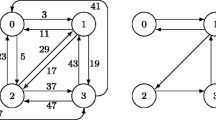Abstract
A language is called (m,n)-verbose if there exists a Turing machine that enumerates for any n words at most m possibilities for their characteristic string. This notion is compared with (m,n)-fa-verboseness, where instead of a Turing machine a finite automaton is used. By use of a new diagonalisation method, where finite automata trick Turing machines, it is shown that all (m,n)-verbose languages are (h,k)-verbose iff all (m,n)-fa-verbose languages are (h,k)-fa-verbose. In other words, Turing machines and finite automata behave exactly the same way with respect to inclusion of verboseness classes. This identical behaviour implies that the nonspeedup theorem also holds for finite automata. As an application of the theoretical framework, a lower bound is derived on the number of bits that need to be communicated to finite automata protocol checkers for nonregular protocols.
Similar content being viewed by others
Author information
Authors and Affiliations
Corresponding author
Rights and permissions
About this article
Cite this article
Tantau, T. Comparing Verboseness for Finite Automata and Turing Machines. Theory Comput Systems 37, 95–109 (2004). https://doi.org/10.1007/s00224-003-1108-4
Published:
Issue Date:
DOI: https://doi.org/10.1007/s00224-003-1108-4




